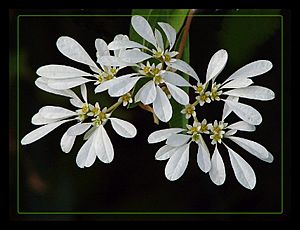Euphorbia leucocephala facts for kids
Quick facts for kids Euphorbia leucocephala |
|
|---|---|
 |
|
| Conservation status | |
| Scientific classification | |
| Genus: |
Euphorbia
|
| Species: |
leucocephala
|
Euphorbia leucocephala is a fascinating plant known by many fun names like little Christmas flower, white lace euphorbia, snow bush, snow flake, snows of Kilimanjaro, and white Christmas bush. It belongs to the plant family called Euphorbiaceae. This plant is special because it grows naturally only in Mexico and Mesoamerica, which is a region in Central America.
Be careful around this plant! Its clear, milky sap can irritate your skin, causing rashes or even blisters. If someone accidentally eats it, it can cause an upset stomach with vomiting and diarrhea. So, it's best to admire it without touching or tasting.
Contents
What is the Snow Bush?
The Euphorbia leucocephala is a type of shrub that can grow quite tall, sometimes reaching up to 10 feet (3 meters) high. It's famous for its beautiful, showy white "flowers," which are actually not true flowers. Instead, they are modified leaves called bracts. These bracts are often bright white, making the plant look like it's covered in snow, especially during the cooler months. This is why it's called the "snow bush" or "snow flake."
Leaves and Flowers
The actual leaves of the snow bush are usually green and oval-shaped. The real flowers are tiny and yellow, found in the center of the white bracts. These bracts grow in clusters at the ends of the branches, creating a lovely, lacy look. The plant often blooms in late fall and winter, which is why it's also called the "little Christmas flower" or "white Christmas bush."
Where Does It Grow?
This plant is native to warm, tropical areas. You can find it growing naturally in parts of Mexico and Central America. It prefers sunny spots and well-drained soil. Because of its beautiful appearance, it's also grown as an ornamental plant in gardens in other warm regions around the world. People often plant it to add a touch of white to their landscapes, especially during the holiday season.
How It Reproduces
Like many plants, the Euphorbia leucocephala reproduces using seeds. After the tiny flowers are pollinated, they produce small fruits that contain the seeds. These seeds can then grow into new plants. It can also be grown from cuttings, which means taking a piece of the stem and planting it to create a new plant.
Interesting Facts
- The Euphorbia family is very large and includes many different types of plants, from small weeds to large trees. One of the most famous plants in this family is the Poinsettia, which is also known for its colorful bracts.
- Even though the sap can be irritating, the plant's beauty makes it a popular choice for gardens and landscaping in tropical and subtropical climates.
- The name leucocephala comes from Greek words: "leukos" meaning white, and "kephale" meaning head, referring to its white flower-like clusters.
See also
 In Spanish: Euphorbia leucocephala para niños
In Spanish: Euphorbia leucocephala para niños


